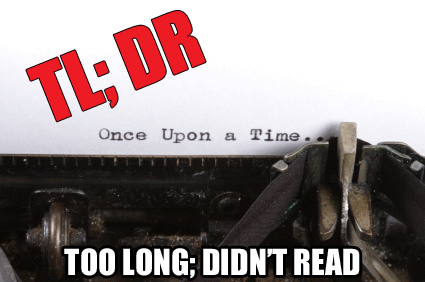 And just like that, I lost over a third of my readers before I even got started with my awesome article (what? you won’t know if it’s awesome or not – you aren’t going to read it all).
And just like that, I lost over a third of my readers before I even got started with my awesome article (what? you won’t know if it’s awesome or not – you aren’t going to read it all).
When all is said and done you will probably only look over about a half of what’s on this page and then only actually read about 20% of it.
Such is the life of an online copywriter.
Kivi and a lot of other really smart people emphasize how important it is to make sure you spend a lot of time crafting your email subject lines, articles headlines and other microcontent because that is what people are really focusing on. They simply aren’t reading the articles or blog posts in full.
But where do we get this idea?
Did one really lazy person with an aversion to reading start this vicious rumor which then spread like medical advice on Facebook?
If only.
No, real scientific people with real scientific instruments have done real scientific research on this. So, for those of you who always ask for studies backing up what we say so you can show your boss, here you go:
How Little Do Users Read? by Nielsen Norman Group. While this study was published way back in 2008, online reading habits have gotten better. Everyone still quotes this study and the one they did in 1997, How Users Read on the Web when discussing this topic. They also published the study detailing that people read in an F-shaped pattern on the web. Jakob Nielsen is kind of a big deal in this area.
Key Finding: On the average Web page, users have time to read at most 28% of the words during an average visit; 20% is more likely.
You Won’t Finish This Article by Slate. Slate had traffic analysis firm Chartbeat look at how people scroll through Slate’s articles. It’s a great case study on the topic.
Key Finding: Readers can’t stay focused and will share articles on social networks even though they haven’t read them fully.
Photos as Web Content also by Nielsen Norman Group. Just so your stock images don’t get an ego.
Key Finding: Users pay close attention to photos and other images that contain relevant information but ignore fluffy pictures used to “jazz up” web pages.
Eyetracking the News: A Study of Print and Online Reading by the Poynter Institute. Just so your print newsletter doesn’t get an ego.
Key Finding: Online readers read more of a story than those reading print.
7 Marketing Lessons from Eye-Tracking Studies from Kissmetrics. This article shares several studies on how people are looking at your website.
Key Finding: People scan emails very quickly so you need to keep newsletters short.
So it looks like no, for the most part, people will not read your whole article. Sorry. Don’t take it personally, though.

It doesn’t mean they don’t like you or what you stand for.
People are busy. People scan. They skim. They look for small takeaways.
Why even bother?
Well, because some people do read everything so you need good stuff for them.
And if you do a good job with your titles and email subject lines, those who don’t always read will start to.
Then, if you do a good job with your highlighted text,
- key points
- in the form of
- bulleted
- lists
and sub headings,
they will read even more.
Then, when they realize you do, in fact, have awesome stuff to say, they will want to read the next thing you publish. Then, when that is awesome too, they will want to read more.
What are your reading habits? Did you actually read this whole post?





